Text
Beyond Evil is one of my favourite shows.
It has an extremely complex plot and a lot of themes, and it attempts directly to criticise both the institution of policing (specifically in Korea, although a lot applies generally), but also the culture of police procedurals and the way that they tend to glorify both morally grey cops skirting the edge of the law and the brutality of the murderers that serve as antagonists. Dong Sik himself was a victim of this same system and the whole show is about him trying desperately still to believe that it can work despite his own poor experiences, whilst at the same time using his lack of faith in the system to punish himself for the way he feels guilty for his sister's and then his neice's deaths.
They use the editing to reinforce these themes, working to make Dong Sik look guilty with particular cuts and cliffhangers, which directly parallels the importance the story puts on reputation and the way the media can ruin a person like Dong Sik with just the perception of guilt. Of course, this is complicated by Dong Sik trying to make himself look guilty, which without the entire context of Dong Sik's past and the events of the night of Min Jung's murder seems to make no sense.
The key theme of this critique is compassion and how lacking compassion in policing leads to poor and often tragic outcomes. The main subject of this theme was Joo Won (the cold, big city cop) vs. Dong Sik (the compassionate, small town cop). The contrast of urban/rural is a fairly traditional theme, and it's expressed fairly traditionally here. However, it's used to explore the theme of compassion by demonstrating a hypocrisy. It reproduces the typical characterisation of small towns as incestuous nests of corruption and secrets, where everybody knowing everybody brews resentment for past wrongs that cannot be overlooked, forgotten, or escaped. And then also it reproduces the typical characterisation of big cities as cold, lonely, and unfriendly places where people are ground up as fodder for the machine.
Joo Won acts as a transplant: he is a cold, lonely tool for his father's political advancement who comes into Manjang like a wrecking ball, uncaring of the lives he tears apart and the relationships that he ruins in his investigation. He recklessly inflames old wounds, such as the disappearance of Jae Yi's mother, when he orders the investigation of the Butcher Shop on a slim and flimsy suspicion. This is not the sort of behaviour that allows people in a small town to live peacefully. As Ji Hoon mentions, these people are trapped together in a small town; they have to learn to let things go and not to poke old wounds. It is this very attitude that allows Don Sik to live a mostly peaceful life despite a lot of the town and his own colleagues having seriously suspected him of murdering his sister and his police chief formerly having attempted to beat a confession from him. Joo Won's misophobia is a metaphor for this coldness: he dresses strictly, acts reserved, doesn't like to get close to people, and doesn't like to get dirty; he literally doesn't like to wade into the murky contamination of human connections and emotion.
But the justification for the cold, big city cop's lack of compassion is the precise and unbending application of the law in order to demonstrate fairness, and whilst Joo Won demonstrates this lack of compassion, he plays fast and loose with the law. In fact, it is Dong Sik rather than Joo Won who cares most for the meticulous application of the law, often reciting laws verbatim and criticising his colleagues who beg him to let little things go, like the cop's wife and her friends who are gambling illegally with small funds.
Joo Won coerced a disadvantaged illegal immigrant into a plot to trap a serial killer using a very ends-justify-the-means mentality, but when she died he found that the ends did not justify the means. He's often extremely loose in his application of the law, blindly focusing on brute forcing his suspect through the investigations, which was exactly the thing that ruined Dong Sik's life as a teenager. Even after he becomes wracked with guilt at the consequences of his own actions, he thinks that the mistake he made was the action of setting up a sting rather than the utilitarian mentality, and so he continues to operate in the same way and all his attempts to atone merely dig him into a deeper hole. On the other hand, in one of Dong Sik's first appearances, he literally gives the shoes off his own feet to a mentally-impaired man who is soaked and lost in the rain.
Of course, Joo Won is not without compassion: it has merely been trained out of him. His reservedness and misophobia is a consequence of childhood trauma, and his cowboy cop attitude is a result of the institutional corruption of the police force being more concentrated in the urban centre where he has trained and worked; but when it comes down to it, he wants to be compassionate. When he has to help chase down the old man with dementia in the reed field with Dong Sik, he hesitates and is aggrieved at getting mud on his designer shoes. But when Dong Sik demands he help pin down the panicking man before he hurts himself, he does do it, diving down into the mud and getting filth all over himself. Joo Won serves as the avatar of the corrupt police institution, whilst Dong Sik serves as the avatar of the reform of the system and the belief that it can be better. That's why it was a really interesting choice to make Dong Sik the elder partner and mentor figure and Joo Won the younger mentee. When Joo Won goes so far as breaking in to Dong Sik's house and threatening him with a gun and to delete the footage of his illegal actions in order to force him to confess to crimes for which he has no evidence, Dong Sik chides him by reminding him that for each way he breaks, bends, and avoids the law, he would be required to compound upon them with more illegal actions to cover them up, to no forseeable end. Joo Won is portrayed as the impulsive younger partner and Dong Sik as the wise mentor with an eye for the future. This demonstrates the short-sightedness of corruption.
Also as the younger partner, Joo Won represents the future of policing, so the decision to make him the corrupt one of the two demonstrates how the institution has become so corrupt that it is producing corrupt cops to continue on its corrupt legacy. Therefore, Dong Sik is there to remind Joo Won that he need not reproduce the failings of his metaphorical forefathers nor indeed of his actual father. This optimism isn't a revolution of a policing as it would be if the reformist were the younger mentee of the pair, but rather a reminder of what policing is meant to be in spirit: the use of the law, all law, for all people, to demonstrate and to enforce fairness and compassion for victims and their families. Law may sometimes be unfair, but it is the job of the reformist to change the law rather than to bend it. For example, when Dong Sik explains to the father in the first episode that he cannot report his son missing due to a quirk of Korean law, but that it is a fault of the law and not of its application.
Dong Sik himself is on the fence about the fortunes of this belief through most the series, which is why he's insane. 20 years before the main timeline of the show, he became completely disillusioned with the system, and he decided that his reformist action was to go into the system and demonstrate compassion on the small scale, himself being the only thing that he can control. Over the years, he becomes satisfied with this. But when Min Jung dies in the same way as his sister died, he is retraumatised, his disillusionment returns, and he decides to take a gamble: he knows who the murderer is and believes that there is not enough evidence for a conviction, so he tests whether his colleagues will investigate with full vigour rather than forming another witchhunt and whether the system will work so that the murderer goes to jail. However, this very action involved the manipulation of evidence, which is illegal, and which voids its court admissibility. It demonstrates that Dong Sik did not believe that the justice system could actually serve justice; it was a test both desperate and spiteful.
In the end, this lack of faith is something that Dong Sik regrets. Joo Won is the one that causes Dong Sik to regain his faith. He acts without compassion but he does not lack compassion innately, only having been taught not to exercise it. Their experiences together teach Joo Won that compassion is a strength, and they give Dong Sik hope for a future of systemic compassion rather than one where he exercises it only in his small field of control. Dong Sik learns that at the point of his manipulation, Min Jung was still alive. If he had not decided to form this test, Min Jung may not have died. As penance, he accepts going to jail for evidence tampering, yielding to the legitimacy of the justice system. Dong Sik's failing was that he lost hope. The original Korean title is Monster, but I do prefer the English title of Beyond Evil. It has a double meaning: "beyond evil" meaning "extremely evil" or "even more evil," which recalls Monster, but also meaning "thinking beyond the concept of evil." It references the justification cops who skirt the law use for their actions: that they are the Good people that are fighting the Evil people, and therefore any action can be justified to make sure those that they deem evil are imprisoned. But, as Dong Sik demonstrates, it is not the arrests you make or the actions you perform as a police officer that matter the most, but the way you treat the people for whom you have become responsible. A police officer's main job is not arrest but investigation: a suspect too is one of the people for whom a police officer is responsible, and labelling someone as evil and then forging evidence and forcing a confession because you think that they're guilty is not conducive to a police officer's duty. This sort of behaviour demonstrates a lack of respect for the suspect, the victim, the families of both the suspect and the victim, the community, and the law.
#beyond evil#kdrama#han joowon#lee dongsik#spoilers#to be clear#acab#this is a very optimistic show#despite the grim subject matter#cop shows are still escapism#suspend your disbelief#this relates a lot to that specific korean law#that says that every effort must be made in order not to allow a suspect to be photographed or filmed wearing handcuffs#because the depiction of a person in handcuffs prejudices a jury to lay down a guilty conviction#there was a study on this i think#i could write so many more essays on beyond evil
2 notes
·
View notes
Text
Why Vampires Are Non-Binary By Default
So we agree that "male" and "female" are adjectives and should be used as such, but what about in fantasy settings, especially as regards post-human species? Can a vampire be called a "man" or a "woman" considering the etymological relationship those words hold to "human"? As post-humans, is it to be treated like the matter of gender identity or would they have separate words for the sexes and gender identities of their species? Post-man? Post-woman? I suppose it depends if the vampires manage to stabilise enough to form societies that can affect distinct language and customs or if they operate instead as a largely asocial or antisocial and therefore diffuse people that scavenge from human societal trappings as they do from human corpses. There's similar considerations to be made for zombies or ghosts (also post-human, but without the aggressive mimicry), but what about werewolves? Is it a separate species or a human with a condition? The name itself implies half-man/half-wolf: are they considered human whenever the moon is not full and use man/woman, etc., and then wolf terms during the fullmoons; or is it actually not at all a split and they are all the time werewolf, which may require distinct terms? But this is operating on the gender binary and clearly not complicated enough. Are all post-human fantasy creatures enbies?
I mean, considering the uniformity of function that tends to be given to these species upon separating from humanity, there could be an argument made that gender roles cease to exist. There's not a huge difference in the capacities, capabilities, or performances of vampires, zombies, ghosts, or werewolves along sex or gender lines (except perhaps again what has been adopted, remembered, or scavenged from human societies, which doesn't seem to effect function as much as facade).
Are they all post-gender as they are post-human? Is ghost a gender?
So far as sex, the post-human species are usually held to be sexually infertile, and any human reproductive organs are non-functional. All but ghosts and including werewolves are presumed to reproduce largely via bite, and all members of the species have mouths and teeth that are structurally and functionally the same: all members all serve a uniform reproductive role. Ghosts die, which is an activity they do alone and to themselves, so it's pretty much asexual reproduction, which is, again, uniform. The sexual dimorphism is again a facade as much as the remnants of human gender. So they're almost certainly unisexual. Unless this is a misunderstanding of the reproductive process. Does the base human operate as feed for the new being or is it the pistil partner that is engaged upon and then births themselves and is their own mother and therefore explains why there's so much vampire incest? Is this mitosis or meiosis? The former would imply unisexual as above, but the latter again would imply some sort of gonochorism.
However, given that the human would always be the one that is "impregnated" to create the new member of the post-human or human-adjacent species who is also themselves, isn't that instead some kind of metaphysical protogynous hermaphroditism like a parrotfish? Is this also why vampires are always bisexual?
But again, the post-human or human-adjacent themselves would always operate as the stamen partner, so we're back to unisexual rather than hermaphroditic. Does this even work given that the point is that vampires, zombies, ghosts, and werewolves aren't human and therefore classifying them with humans as though it were some kind of sexual dimorphism is nonsensical? Or is it fine because they're post-humans and therefore metaphysically the same species?
I haven't slept in I can't remember.
#ghosts are post-human asexuals#this is why poltergeists exist#it's all the compressed inner rage#vampires#ghosts#zombies#werewolves#enbies#edited later for clarity
2 notes
·
View notes
Text
Ever since i was a little girl i knew i never wanted to be pregnant
#i vaguely thought that it was weird#until my mum got pregnant again#and then my foetus sister kicked my head from inside the womb#and I knew then that it was an abomination#by which I mean the concept of pregnancy#but also my sister
40K notes
·
View notes
Text
Valyrian kinship terms, Targaryen incest, and non-patrilineal inheritance
So, there are between 4-6 kinship systems depending on how you count. The six are below, but they can be reclassified as 1) lineal kinship (Inuit), 2) generational kinship (Hawaiian), 3) descriptive kinship (Sudanese), and 4) bifurcate merging kinship, which has three types: bilateral (Iroquois), patrilineal (Omaha), and matrilineal (Crow).

If you count as 6 kinship systems.
The English language uses the lineal (Inuit) kinship system. David J. Peterson, who created the Valyrian conlang, chose to use the bilateral bifurcate merging (Iroquois) kinship system for High Valyrian, which has less discriminatory terms than the lineal kinship system.
The lineal kinship system focuses heavily on whether someone is or is not part of the nuclear family. Members of the nuclear family have distinct words based on generation and gender (mother, father, brother, sister). However, there are less specific terms for those outside the nuclear family: the female siblings of one's parents all have a single term (aunt), the male siblings of one's parents all have a single term (uncle), and one's uncles' and aunts' children all have a single term that doesn't discriminate by gender (cousin).
Bilateral bifurcate merging kinship is different in that there is a single term for one's father and all his male siblings, a single term for one's mother and her female siblings, and then a term each for the siblings of cross-sex of one's parents. Similarly, the children of the same-sex siblings of one's parents (parallel cousins) are referred to with the same term as one's brothers and sisters (dependent on gender); however the children of the cross-sex siblings of one's parents (cross-cousins) all have a different single term that doesn't discriminate by gender.
High Valyrian follows the bilateral bifurcate merging kinship but additionally discriminates by relative age for most relatives, as shown below.

High Valyrian kinship terms (bilateral bifurcate merging with a relative age modification)
What does this say about Valyrian culture?
Some people have argued that this is meant as a manifestation of a commonplace practice of incest in Valyrian culture. However, it's actually the opposite.
I would like to quibble a little here about the term "incest." To be clear, whilst some cultures practice types of cousin marriage, they wouldn't consider it "incest." All humans are related to some degree, and biological incest is not a hard line, but rather a probability curve that maps the likelihood of recessive genetic disorders and mutation. "Incest" is the cultural term that draws that hard line: it is the intermarriage of relatives too close to be culturally permissible. It's more accurate to say that the question isn't whether or not the Valyrians practiced incest but what level of genetic relationship they considered to be incest.
So, whilst it's correct to say that Targaryens practiced incest according to Westerosi cultural principles (and the principles of the modern West), it is only correct to say that Targaryens practiced incest if the level of intermarriage that they allowed was not culturally permissible in Valyria. Since the Targaryens immigrated to Westeros, it becomes a moot point, but when talking about pre-Doom cultural practices, a little investigation is required.
Firstly, Word of God1:
[https://www.historyofwesteros.com/george-rr-martin-in-conversation-how-interviews-grrm/] Excerpt:
Ashaya: Let’s ask about a couple questions about Valyrians that I have here… did Valyrians from non dragon riding families practice incest as well*? And did Valyrians other than Targaryens have dragon dreams, if you can answer either of those?*
George: No, I don’t think they particularly would*. I haven’t really thought about that.*
Ashaya: Okay. Fair enough.
George: I reserve my right to change my mind, but no, I don’t think. There was a specific reason for the incest which was to uh, you know, I mean, obviously they don’t have… these are medieval people and ancient people.
They don’t know about DNA or genes or any of that stuff, but they have some rough concept of it in which they attribute to the blood. This guy has blue eyes and his children have blue eyes, but if he marries someone with brown eyes, now all the kids have brown eyes, why is that?
They have some things, so… we can control dragons, we don’t wanna lose that ability, not everybody can do that. So we better keep it in the family, so to speak*, or at least with the other dragon riding families. Now there was, I haven’t gone much into it, but* there was another very powerful group in Valyria who were not necessarily the dragon riders. And those were the people who practiced blood magic. And which, you know, there’s some overlap in the Venn diagram with the dragon riders, but not necessarily complete overlap. And then there were just the regular people. There were a lot of slaves cuz it was a slave society. There were a lot of poor people. I think of ancient Rome or something like that. I don’t know that they would have any reason to to practice incest.
Here, GRRM states that it's unlikely incest was the common practice in Valyria: incest was used as a form of privileged consolidation of power in a society where certain powerful families practiced blood magic and particularly where a family's blood magic allowed them to control dragons. So, incest was less a Valyrian practice than a dragon-riding or perhaps Targaryen practice, and the level of intermarriage they practiced was likely closer than was permissible in Valyria.
Secondly, the choice of kinship systems supports that nuclear family intermarriage wasn't a commonplace Valyrian practice. There's been studies of kinship systems and the prevalence of incest and it's been found that the less discriminatory the kinship terms, the more distantly related one had to be to be a permissible marriage partner. So a generational (Hawaiian) kinship system is more likely to prohibit all types of cousin marriage, whilst a bifurcate merging kinship system is more likely to permit cross-cousin marriage of some types, depending on whether its bilateral, patrilineal, or matrilineal. [Source: https://research-information.bris.ac.uk/ws/portalfiles/portal/202655238/Full_text_PDF_final_published_version_.pdf ]
Generally, the terms that are rendered in the diagram above for the bifurcate merging kinship systems (Iroquois, Crow, and Omaha) as "brother" or "sister" tend not to be permitted as marriage partners. This would imply in fact that some permissible Westerosi marriages (such as Tywin Lannister and Joanna Lannister, whose fathers were brothers, making them parallel first cousins) would be considered incest in Valyria.
So whilst the use of a bifurcate merging kinship system in High Valyrian implies the Targaryen practice of nuclear family intermarriage was not common, it does imply something else: the inheritance system may not have been patrilineal. Amongst the three types of bifurcate merging kinship systems, the bilateral system used for High Valyria implies that matrilineal and patrilineal relatives were considered equally or ambiguously important.
The patrilineal bifurcate merging (Omaha) kinship system places more importance on the patrilinear relatives, whilst the matrilinear relatives have less specific terms that distinguish largely on gender and not on generation: this is why one's mother's brother and his son have the same single term and why one's mother's brother's daughter uses the same term as the mother and her sister; the terms mean something closer to "male matrilinear relative" and "female matrilinear relative" as opposed to the more specific separate "cousin" term used for the children of one's father's sister. The matrilineal bifurcate merging (Crow) kinship system is the mirror image of this. The specific terms would be necessary for when it's important to distinguish relation, for example during legal disputes such as inheritance.
That the High Valyrian bilateral bifurcate merging system does not have this lopsidedness implies that whether the relative is patrilineal or matrilineal, an equal amount of specificity is required. This may imply that inheritance could pass through either the male line or the female line of inheritance.
#house of the dragon#fire and blood#targaryens#targaryen incest#kinship systems#kinship terms#high valyrian#crossposted#a song of ice and fire#asoiaf#game of thrones
37 notes
·
View notes
Text
Anatomical question regarding dragons: since the front bone of their wings seems to be used as an arm, does that make them like flying squirrels?
0 notes
Text
I've just had a horrid thought. Do you think that Aegon said "Dracarys!" whenever he came?
1 note
·
View note
Note
rytsas, I've been learning valyrian lately and got to the kinship terminology. As perplexing as it is I think I understood it. But why did the words for father and father's brother merge? Was the terminology in any way affected by the fact that the valyrians practiced incest? Are there words for grandparents? if not, is the dictionary growing? I have so many more questions... love your work, kirimvose.
The words didn’t merge: Children call their father kepa, and their father’s brother kepa. Valyrian’s is one of the six basic types of kinship systems—specifically the Iroquois system. If you haven’t seen this image before, this should explain it:

Only two of the systems actually use different terms for a maternal aunt and paternal uncle. The system we use in English happens to be one of those.
Also, for ease of reference, this is what the High Valyrian image looks like:

Though, of course, the vowel should be long in ñābranna.
The dictionary is always growing. I’ll continue to work on my languages till I’m dead.
Thanks for the ask!
217 notes
·
View notes
Text
No wait, who am I kidding. Stanley couldn't shoot straight if Xeno got on his knees and begged him to wear a less fruity lipstick. Don't get me wrong, he hits the bullseye every time, but that's only because the bullets he shoots are so bent they do loop-de-loops in the air spelling out 'Marry me, Xeno!' in the schoolgirliest cursive you've ever seen before hitting the target. Stanley only has blue balls because Xeno's into that. You've seen Xeno in those claws. What are those if not a chastity device or some really flaming CBT. That X on his face is for X-rated, and he calls himself Xeno because what he's into is so out there. He's Houston because he's always about to achieve lift-off. He's Wingfield because he's always following behind that warrior man.
Look, if these two aren't fucking it's only because Stanley thinks the blue balls make him shoot straighter.
#stanxeno#doctor stone#dr stone#i admit i had to stretch with the last one#but it's actually etymological
40 notes
·
View notes
Text
Look, if these two aren't fucking it's only because Stanley thinks the blue balls make him shoot straighter.
40 notes
·
View notes
Text










I asked people their favourite EPIC: the musical song and drew silly, rough sketches about them (sorry)
11K notes
·
View notes
Text
The Frog at the Bottom of the Well by Zhuang Zi or 井底之蛙 jǐng dǐ zhī wā a frog in a well
and
कुपमण्डुक kupamanduka well-frog
All I'm saying is that it was Maomao who did it and not the butler.
#kusuriya no hitorigoto#the apothecary diaries season 2#maomao#jinshi#jinmao#frogs are now a literary device
10 notes
·
View notes
Text
How to Consume The Apothecary Diaries
TLDR
Web Novel: A Pharmacist's Monologue, 387 chapters. Free in Japanese; English Translate MTL is very easy on-site. HERE.
Light Novel: The Apothecary Diaries. Partially free with an account HERE. Also Google exists. Purchaseable in Kindle/Print. 15 Japanese volumes (approx. 363 WN chapters) and 13/14 English volumes on Kindle (approx. 323/347 WN chapters) or 4/5 English volumes in print (approx. 101/128 WN chapters). Available on Amazon, Ebay, Abebooks, Facebook Marketplace. Use Bookfinder to compare prices.
Manga: x The Apothecary Diaries, ill. by Nekokurage. This illustration style is very similar to the anime. 80 manga chapters have been released. 14 Japanese volumes (74 M1 chapters, approx. 89 WN chapters, approx. 3.75 LN volumes) and 13 English volumes (68 M1 chapters, approx. 83 WN chapters, approx. 3.5 LN volumes). Available on Amazon, Ebay, Abebooks, Facebook Marketplace. Use Bookfinder to compare prices. x Maomao's Notes from the Inner Palace, ill. by Minoji Kurata. This illustration style is similar to the light novel. 84 manga chapters have been released. 19 Japanese volumes (82 M2 chapters, approx. 101 WN chapters, 4 LN volumes). There is no official English release.
Anime: The Apothecary Diaries, 29 episodes and currently airing weekly. 1 full season (42 M1 chapters or 8 volumes, approx. 31 M2 chapters or 7 volumes, approx. 56 WN chapters, 2 LN volumes). Season has 5 aired episodes as of last week (43-49 M1 chapters or volume 9, approx. 32-39 M2 chapters or half volume 8 with full volume 9, approx. 57-68 WN chapters, half LN volume 3). Season 2 will have 24 total episodes totalling to 48 episodes (possibly passing the manga release of 80 M1 chapters or 14 volumes, approx. 82 M2 chapters or 19 volumes, approx. 101 WN chapters, approx. 4 LN volumes). Free with ads on Crunchyroll. Conditionally free without ads with a Crunchyroll subscription or free trial. HERE.
Here's a spreadsheet:

Link
The Specifics
The Web Novel The Apothecary Diaries (or, A Pharmacist's Monologue) is published in Japanese for free as a web novel by Natsuo Hyuuga in 2011 on Shōsetsuka ni Narō [Let's Become a Novelist]. It is still ongoing, and the 387th chapter was published as recently as 5th February 2025. You can access it for free here. The webpages are easy to Google Translate, so if you don't mind MTL, the English translation also is free and easily accessible. To do this, right click anywhere on the webpage and select 'Translate to English'. Additionally, the website has an option to download a PDF of the entire novel. However, this is only in Japanese vertical script, and it is less easy to Google Translate.
The Novel There was a print novel of The Apothecary Diaries illustrated by Megumi Matsuda published in Japanese in 2012. It comprises a single volume, which covers 66 chapters of the web novel (the only chapters that had been released at the time). I am not aware of the availability of any English translation of this novel.
The Light Novel The Apothecary Diaries is being adapted into a light novel written by the same Natsuo Hyuuga and illustrated by Touka Shino. Some chapters are available for free on J-Novel here, but the rest require purchase. There is no legal way to access the full light novel for free. However, I have heard that Googling is easy and very profitable. The Japanese volumes began releasing in 2014. As of February 2025, there are 15 volumes in print, covering approximately 363 chapters of the web novel. The official English language release began in 2024. The English print release is around 3 years behind the Kindle release. As of February 2025, 13 volumes are available on Kindle, covering approximately 323 chapters of the web novel. The 14th volume will be released in May, covering approximately 347 chapters of the web novel. You can find these on Amazon for £6.39 each. As of February 2025, 4 volumes are available in print, covering approximately 101 chapters of the web novel. The 5th volume will be released in May, covering approximately 128 chapters of the web novel. You can find these new on Amazon or Ebay for around £13-17. You can find them secondhand for as low as £9 on Amazon or Abebooks. You can use Bookfinder to compare the prices between book vendors. Additionally, Facebook Marketplace is an underused resource.
The Manga The Apothecary Diaries is being adapted as 2 separate manga series by Itsuki Nanao. I don't know why. There are differences between the adaptations, and there are differing opinions on which one is better; I won't get into that here. I will refer to them separately as The Apothecary Diaries and Maomao's Notes from the Inner Palace. x The Apothecary Diaries is the manga adaptation illustrated by Nekokurage that began releasing in Japanese in 2017. 80 manga chapters have been released as a monthly serial. The illustration style is extremely similar to the anime. There are currently 14 volumes in print in Japanese (up to manga chapter 74), covering approximately 89 chapters of the web novel or 3.75 volumes of the light novel. The official English language release began in 2020. There are currently 13 volumes in print in English (up to manga chapter 68), covering approximately 83 chapters of the web novel or 3.5 volumes of the light novel. The 14th volume will release in October. There are Kindle versions; you can find these on Amazon for £5.65 each. You can find print versions new on Amazon or Ebay for around £10-13. You can find them secondhand for a similar price on Amazon, Ebay, or Abebooks. You can use Bookfinder to compare the prices between book vendors. Additionally, Facebook Marketplace is an underused resource. x Maomao's Notes from the Inner Palace is the manga adaptation illustrated by Minoji Kurata that began releasing in Japanese in 2017. 84 manga chapters have been released as a monthly serial. The illustration style is more similar to the light novel than to the anime. There are currently 19 volumes in print in Japanese (up to manga chapter 82), covering approximately 101 chapters of the web novel or 4 volumes of the light novel. The 20th volume will release in September. There is no official English language release.
The Anime The Apothecary Diaries is being adapted as anime. It has one complete season of 24 episodes, and season 2 is currently airing weekly. Episode 5 was released last week. Season 1 covers approximately 56 chapters of the web novel or 2 volumes of the light novel or 8 volumes of The Apothecary Diaries manga or just over 7 volumes of Maomao's Notes from the Inner Palace. I expect season 2 wholly to cover approximately chapters 57-101 of the web novel or the 3rd and 4th volumes of the light novel, possibly exceeding the currently manga release with the 9th-14th volumes of The Apothecary Diaries manga or the latter half of the 8th volume through the 19th volumes of Maomao's Notes from the Inner Palace. You can access it in dub and sub on Crunchyroll here. It is free with ads. You can watch it without ads by subscribing to Crunchyroll for £4.99/mo. The first subscription on a Crunchyroll account includes a 7 day free trial. This requires you to enter your payment information before granting access. However, if you cancel the trial immediately after subscribing, you will retain access to the subscription services for the remainder of the trial period without worrying about the subscription charging your card at the end.
Edit 250215S: some corrections regarding the length of season 2 of the anime. Thanks to @blur0se for bringing that to my attention.
#i wrote this twice#i accidentally deleted it whilst halfway through#i am so behind on my master's assignments#kusuriya no hitorigoto#apothecary diaries#the apothecary diaries#maomao's notes from the inner palace#the apothecary diaries season 2
869 notes
·
View notes
Text
Batman: Year One (1988) by Frank Miller and David Mazzucchelli
My Batman reading order begins. Mind that this is as much a test as anything. Also, I have already read The Long Halloween as a sneak peak, but I swear that otherwise I'm a DC comics virgin. Batman: Year One by Frank Miller contains Batman (1940-2011) #404-407, which were printed first in comic serial 1996-1997, and which started out the post-Crisis on Infinite Earths continuity on the New Earth. They contain the revamped origin story for Batman. I have acquired the 1988 TPB recoloured edition by Richmond Lewis. This is the volume most often recommended for a few reasons: 1) Richmond Lewis was the colourist also for the original serial, so the collected edition was an opportunity for the original colourist to spruce up the comic with a wider variety of colour than was possible in 4-colour newsprint comics. She is also married to David Mazzucchelli, who was responsible for the linework, so the artistic vision was really kept in-house. 2) This volume is much cheaper than other options that include the recoloured pages, such as the hardcover Absolute Batman: Year One. 3) This volume is also generally fairly cheap, especially if you're not overly attached to mint or brand new copies. My extremely well-preserved 1st edition cost less than £10 on Ebay.
Frank Miller often is credited (or accused) for the grittiness and cynicism of modern Batman and Batman comics--his approximately contemporaneous 1986 Elseworlds limited miniseries The Dark Knight Returns was a major influence on Snyder's grimdark DCEU movies, and he's known generally for sucking out all the ideological sincerity, compassion, and ironic absurdity from Batman. In the 1988 introduction to Batman: Year One, Frank Miller declares, "For me, Batman was never funny." However, that's not precisely borne out in the Batman: Year One comic. In Batman: Year One, Batman might be objectively terrifying to most of his fellow Gothamites, but to his audience he's meta-narratively hilarious. For example, the comedy of errors that is Bruce Wayne's first vigilante-preparation outing. Batman (1940-2011) #404: 25-year-old Bruce Wayne ventures out into the East End of Gotham on 11 March, shortly after his return from abroad. He doesn't yet have the Bat costume, or the specific idea of Batman. Instead, he pastes on some make-up for a recon mission in preparation for his debut as an as-yet-unnamed vigilante. In the process, the following sequence of events occurs:
He vows not to use violence on this recon-only mission
He immediately picks a fight with a street pimp
He gets stabbed and then beaten up by a few sex workers
He gets attacked by a pre-Catwoman Selina Kyle
He punches Selina Kyle in the face
He gets shot by a cop
He gets arrested
He beats up the two cops who arrested him and totals the police car
He gets back into his Bruce Wayne Porsche whilst in his undercover makeup and leaking blood from several holes, a car so recognisable that Jim Gordon, a new transfer cop from Chicago, recognises it on sight
He nearly drives Jim Gordon off the road in such a way that Gordon has no choice but to conclude that he's on cocaine
He gets home and collapses on the floor and then has to call Alfred to come and stitch him up.
Of course, this is great. It's violent, but it's very funny. It's a shitshow. Batman has absolutely no fucking idea what he's doing. It's hilarious alongside its objective textual violence, this sequence alone including: implied underage sex work, a stabbing, police corruption and violence, a bullet wound, several battery assaults, and an explosive car accident. The irony of this happening on what Bruce Wayne vowed to be a non-violent recon mission is arresting, and that's besides Wayne here acting as a slapstick comic as everyone gets their licks in on the man who has sworn to clean up the streets of the whole city.
On top of this, the Batman investigation team headed by Lt. Jim Gordon and Det./Sgt. Essen has two first suspects for the Bat vigilante: Harvey Dent (on account of motive and physical profile) and Bruce Wayne (on account of extremely public motive and massive amounts of money). Bruce Wayne is really not very good at this whole vigilante thing.
Possibly the funniest thing to come out this plotline comes from the scene where Lt. Jim Gordon goes to question Harvey Dent in his office regarding his alibis for the dozens of assaults committed recently by Batman. Harvey Dent calmly refutes Gordon's accusations and sends him off. And then we get this panel:
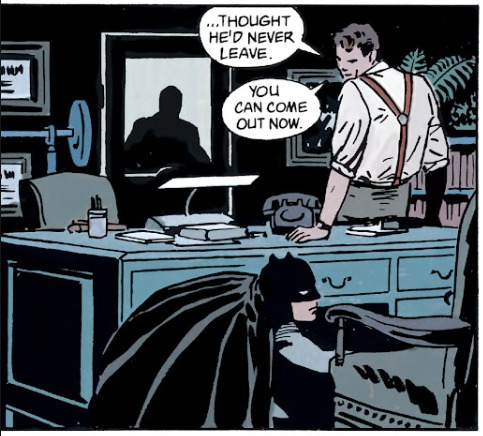
where it is shown that Harvey Dent had been hiding Batman under his desk during the whole questioning. [Batman (1940-2011) #405 | B:YO p. 41] That isn't to say that Batman isn't scary at all. There are some generally creepy-seeming scenes, such as when he breaks in to the Commissioner's house whilst he's having a dinner party with the mob, cuts the power, and then gives an ominous speech in Batman (1940-2011) #405. And later, Batman does become more competent. To escape a SWAT killbox in Batman (1940-2011) #406, Batman uses an experimental infrasonic broadcast device to summon a horde of bats. They bite the SWAT on the arse. I'm sure it was very scary, but also it's very funny. The hilarity isn't kept entirely meta-textual. Although Batman is textually scary, he is also textually mocked. As Batman grimly does mostly-naked, one-armed push-ups on the floor of his sitting room whilst reviewing a stake-out recording and muttering about Carmine Falcone, Alfred provides commentary from an armchair whilst reading the newspaper: "Master Bruce--I've just come across a fascinating piece in the Times. Concerns the effects of lack of sleep among the marginally sane...'marked increase in paranoia'...hmm...'tendency towards aberrant, even violent behavior'...Off again, sir? Shall I fetch your tights?" [Batman (1940-2011) #407 | B:YO pp. 87-88]
There's also the hilarious implication that Lt. Jim Gordon was basically John McClane in his youth. In Batman (1940-2011) #404, Lt. James Gordon transfers in from Chicago to Gotham City, which has a Reputation for crime; during his intake interview, he feels the need to apologise to Commissioner Loeb for the "mistakes" he's made that have turned up on his record—mistakes that the corrupt Commissioner waves off and about which he seems quite pleased. Gordon also spends the entire miniseries doing things like punching a schizophrenic man who has three hostages and a gun to his head. beating up a corrupt coworker and hogtying him naked in the snow, maliciously complying with non-interference orders, ratting out corrupt cops in a district comprised only of corrupt cops, punching people, shooting people, and stealing a motorcycle to rescue his newborn son who has been kidnapped by a mobster. From this, I can only conclude that Jim Gordon was a maverick cowboy cop in Chicago that (voluntarily or not) was put out to pasture after too many marks on his record and/or his wife getting pregnant.
In conclusion, whilst I'm sure that Frank Miller likely did contribute to the edgification of Batman, his claim that "Batman was never funny" isn't an author's mandate against the humour inherent in the character and the franchise—at least as can be seen in Batman: Year One. I would suggest that Batman only started to become such a serious downer when the influence of the Elseworlds miniseries The Dark Knight Returns began to seep into the canon, but I would have to check back on that.
Additional notes:
Carmine Falcone and his nephew Johnny Vito attempt to fend off Catwoman from a break-in whilst dressed only in towels. This is quite funny. [Batman (1940-2011) #407 | B:YO p. 87]
Whilst trapped in the SWAT killbox, Batman saves a cat from the SWAT team and then beats up the SWAT officer who attempted to shoot the cat. This implies that indeed Bruce Wayne's adoption addiction is heritable; Damian Wayne has only contracted the initial stages, as depicted here. [Batman (1940-2011) #406]
It is implied that Jim Gordon may know who Batman is by the end of the comic; Bruce Wayne saves Jim Gordon's newborn son James after he is thrown from a bridge by Johnny Vito, and he does so without wearing a mask, and then he looks Jim Gordon straight in the face. At the time, Gordon says: "You know, I'm practically blind without my glasses. Sirens coming. You'd better go." It's unclear how true this is. [Batman (1940-2011) #407 | B:YO p. 95]
#batman#batman comics#review#batman: year one#frank miller#david mazzucchelli#richmond lewis#batman: year one (1988)#batman (1940-2011)#my batman reading order#it's actually extremely funny#i do recommend#spoilers#batman spoilers
1 note
·
View note
Text
I think it's really charming when ESL fanfic writers accidentally let slip some words from their native language in their fic. I've seen French, Dutch, and some Spanish before in English-language fics. My favourite was the French author who accidentally used garde-robe instead of wardrobe. It's a real show of accomplishment because it's usually the only flaw in what is otherwise perfect English, and it makes me appreciate even more how much effort went into writing.
0 notes
Text
I hate spam, but I've realised that I would feel deprived without my semi-regular "You are the Chosen One!" emails. I like to think this is what happened with Snow White's evil stepmother.
0 notes
Text
Nightwing and Mirage receipts, part 1
So, I've been looking into collecting Batman comics lately, and I realised that I didn't actually know which comics issues had the famous Nightwing/Mirage sexual assault plotline. Whilst looking into this, I found out some interesting things. These things are under the cut with all the MAJOR SPOILERS.
Arc Length and Collections
The first part of the Nightwing/Mirage plotline happens in The New Titans (1984-1996) #79-80 and #85-99, Team Titans (1992-1994) #1-3, Deathstroke, the Terminator (1991-1996) #14-16, and the Titans Sell-Out Special (1992) #1. She also possibly appears in Deathstroke, the Terminator (1991-1996) #13.
Mirage first appears in The New Titans (1984-1996) #79. This is in the midst of the Titans Hunt storyline [the storyline comprises The New Titans (1984-1996) #71-84 and has yet to be collected. It is NOT collected in the Titans Hunt (2016) TPB]. She appears a few more times in The New Titans (1984-1996) until the Total Chaos storyline begins. These issues are collected in the Titans: Total Chaos (2018) TPB:
Deathstroke, the Terminator (1991-1996) #14
The New Titans (1984-1996) #90
Team Titans (1992-1994) #1 (part: Childhood's End)
Deathstroke, the Terminator (1991-1996) #15
The New Titans (1984-1996) #91
Team Titans (1992-1994) #2
Deathstroke, the Terminator (1991-1996) #16
The New Titans (1984-1996) #92
Team Titans (1992-1994) #3
Team Titans (1992-1994) #1 (part: Killowat; Mirage; Nightrider; Redwing; Terra) [The Mirage part includes Mirage's backstory.]
The New Titans (1984-1996) issues after this are not collected.
MAJOR SPOILERS AHEAD.
Timeline Part One: Starfire Imposter
With the range out of the way, there's the actual sequence of events, which is quite a lot worse than I used to know.
The gist about Mirage is that she is from an (alternate) future timeline where the Titans have been replaced with Team Titans, which is headed by Nightwing* but with an otherwise completely different cast. She is a member of the Team Titans and in a romantic relationship with Nightwing*. She and the Team Titans have come back in time for unimportant reasons.
Mirage first sees present-day Nightwing in The New Titans (1984-1996) #85, when he is on the news; she thinks that she's "interested" in him and later thinks ominously "he'll be mine." In The New Titans (1984-1996) #86, she spends some time spying on him and his girlfriend Starfire (Koriand'r/Kory Anders). Later, Dick Grayson appears at Starfire's apartment.
During this time, Starfire and Nightwing are having some relationship issues. Starfire is largely out of commission due to an injury and having a hard time, and Nightwing is contemplating commitment as a way to prevent her from drawing away. Due to secret identity shenanigans, (as Starfire doesn't have a public/private identity split and Nightwing/Starfire are a known couple), Dick Grayson wears a disguise when he's out in civvies with Starfire. In The New Titans (1984-1996) #87, Nightwing wonders: "would Kory even recognise me, if I showed up without a disguise?"
Later, he visits Starfire's apartment and kisses her. This is photographed by a paparazzi, and the paparazzi's internal monologue allows the inference that this is Mirage shapeshifted as Starfire (she seems to have entered the apartment earlier whilst shapeshifted as Dick Grayson).
In The New Titans (1984-1996) #88, Mirage as Starfire gives Nightwing a makeover, and thus ends Discowing. Nightwing notices that something has been different about Starfire lately: she's become less distant, and he describes her as "almost ravenous".
Mirage appears as Starfire in The New Titans (1984-1996) #89 and meets the team; she separates at some point and they all spend some time complimenting Starfire. She also possibly appears in Deathstroke, the Terminator (1991-1996) #13 in a pose with the Titans as Nightwing here is post-Discowing. In Deathstroke, the Terminator (1991-1996) #14, Mirage as Starfire appears with Nightwing and the Titans. She appears largely useless, implying that Mirage is unable to mimic the powers of the people into whom she shapeshifts. The Titans notice and mention that Starfire has been dressing more provocatively lately. Nightwing and Mirage as Starfire appear in a scene where it is implied that they were physically intimate. This is rape by fraud. This scene is intercut with someone snapping ropes that are binding their wrists. Mirage as Starfire leaves.
Later, The Titans (without Mirage as Starfire) are together and Starfire bursts in. She says: "Didn't any of you care? Didn't anyone notice I was missing? I was chained up in that tenement for days. Why weren't you looking for me?" In The New Titans (1984-1996) #90, Starfire says that she's been held prisoner for "the last few days." The Titans realise that the recent Starfire has been an imposter. Pantha says: "Look at 'Wing, there. He should have known. After all, he and the other Star were real kissy while you were, um...out." She also mentions explicitly that Dick "slept" with the imposter, which should perhaps be taken as Pantha's inference, but is grosser considering that Pantha has enhanced smell. Pantha continues through the arc to make extremely gross comments.
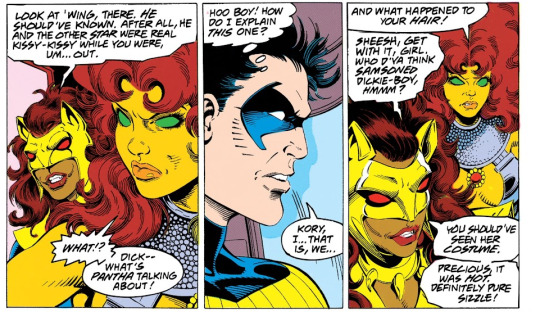
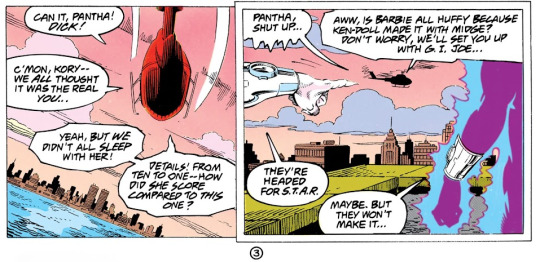
Initial reactions by Starfire do seem to blame Mirage, but Starfire only becomes jealous. She does not process Mirage's actions as rape by fraud, rather that Mirage "made Dick love her." She confronts Mirage and calls it "trick[ing] Dick into bed," but she does not seem to consider it an act of violence. Later, she recognises Mirage as the one who replaced her.
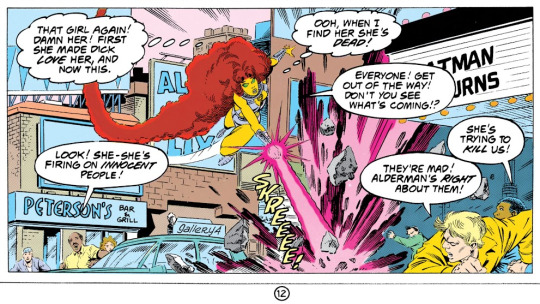
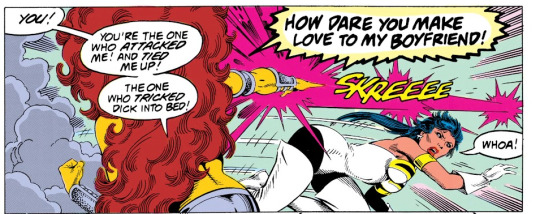
In Team Titans (1992-1994) #1 (part: Childhood's End), Mirage finally introduces herself to Nightwing whilst the Titans and the Team Titans are fighting each other for unimportant reasons. She says that in 10 years he will "love me [her]." On hearing this, Starfire becomes extremely jealous and territorial and physically attacks Mirage. Once everyone calms down, Mirage begins to make nice with Nightwing, who seems receptive. Starfire remains very jealous. Mirage has yet to show off her shapeshifting powers and Starfire has yet to mention that Mirage was the one who replaced her.
In The New Titans (1984-1996) #91, Mirage reminisces on her relationship with future Nightwing*, which she implies was serious.
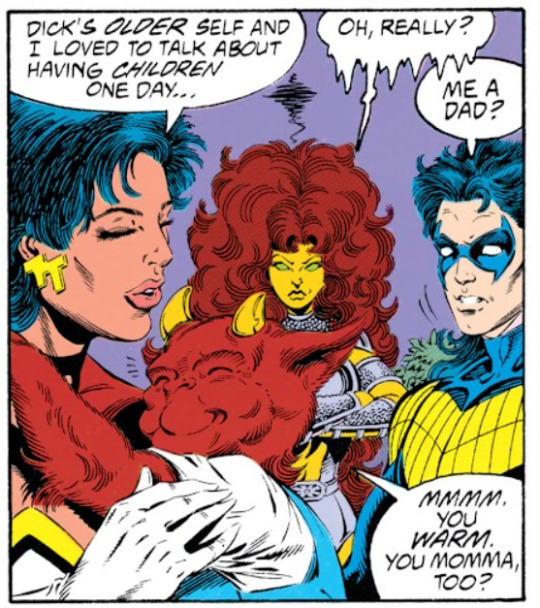
Later, the Titans and the Team Titans get into another fight for unimportant reasons. The Team Titans leave, but Mirage defects to the Titans.
Team Titans (1992-1994) #2 has the reveal that Mirage was the Starfire imposter and the infamous panel that gets so bandied about [it's on page 8].
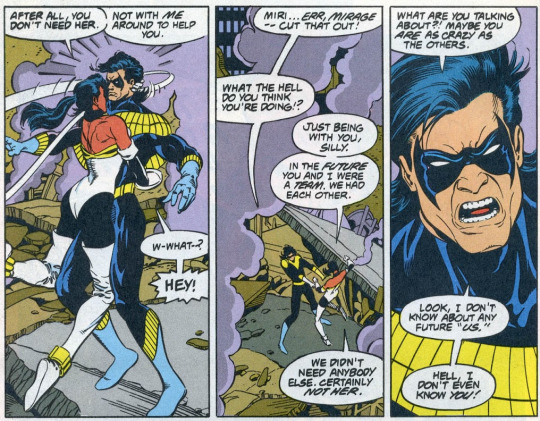
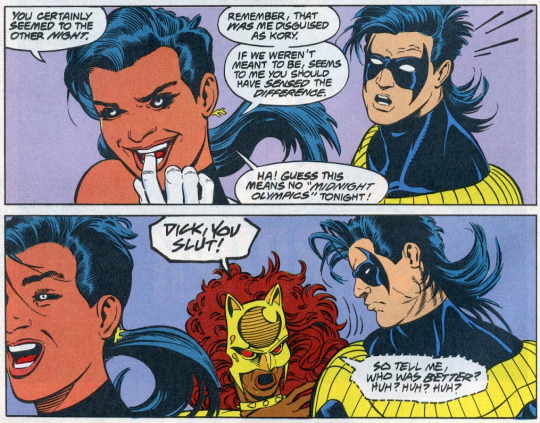
They're in the middle of a fight, so they continue fighting together after this.
Mirage appears next in The New Titans (1984-1996) #92, then in the Titans Sell-Out Special (1992) #1, and continues to appear in The New Titans (1984-1996) #93-96. She spends her time flirting with Nightwing and needling at Starfire. Nightwing firmly and repeatedly rebuffs her; Starfire is insecure. In The New Titans (1984-1996) #93, Mirage shapeshifts into Starfire and poses for two nude centrefolds in a magazine. This is sexual harassment. The Titans don't react especially sympathetically to Starfire.
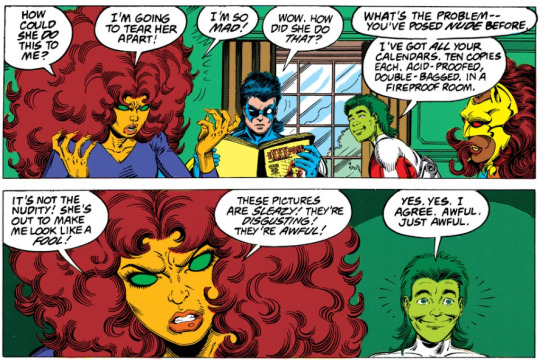
In The New Titans (1984-1996) #94, the paparazzi photo from #87 is published, and a break-up rumour about Nightwing/Starfire takes hold; it is also stated that Mirage sexually assaulted Starfire, likely in #86:
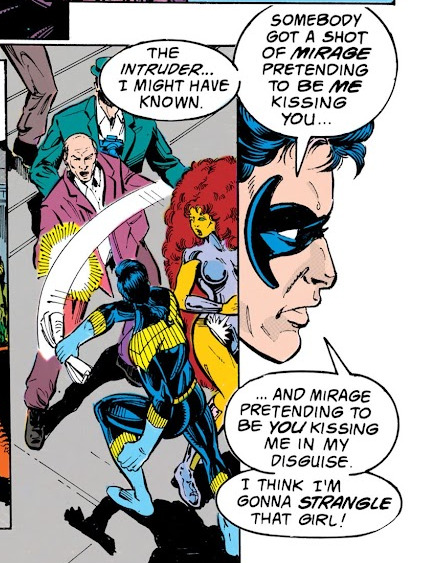
Later and continuing into The New Titans (1984-1996) #95, the writers make the baffling decision to have Dick Grayson and Mirage start fake-dating. Nightwing is endeavouring to start a playboy persona for Dick Grayson by going on dates with Mirage transformed as different women:
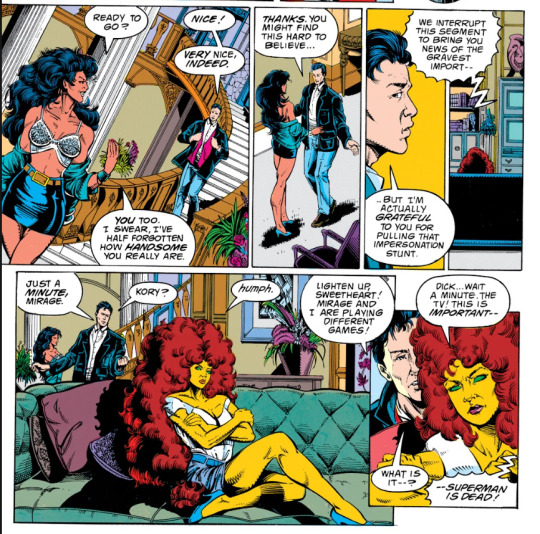
Around here, the attitude of the characters towards Mirage begin to change. Starfire minimises Mirage's sexual misconduct and rape, calling them "the stunts she pulled," but arguing that "she really seems to care for you, Dick."
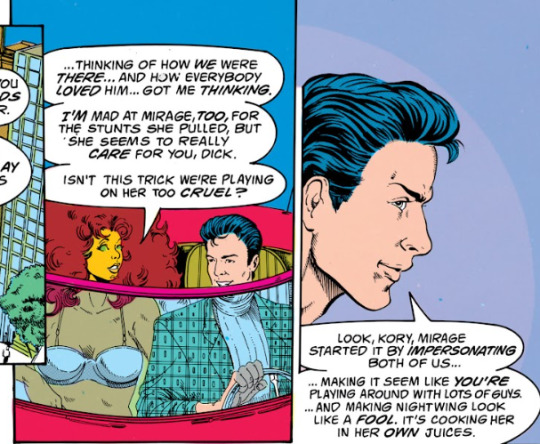
Nightwing arranges for Dick Grayson to be photographed kissing Starfire by paparazzi as part of a scheme to have Nightwing/Starfire break up so that Dick Grayson/Starfire can date without compromising his secret identity. In The New Titans (1984-1996) #96, Mirage is annoyed by the recent paparazzi photos and threatens more sexual harassment:
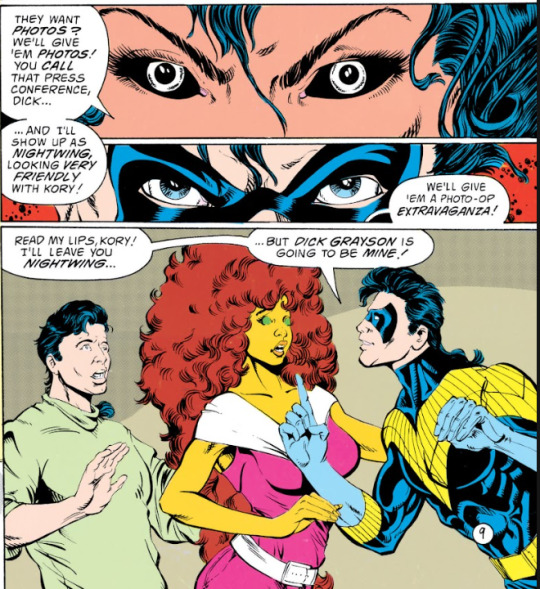
Unable to get between Nightwing and Starfire, Mirage appears briefly to transformed as Nightwing to punch Dick Grayson in the face in front of a dozen reporters (giving him a solid alibi as Nightwing), and then runs off.
In The New Titans (1984-1996) #97, Dick Grayson and Starfire break up, with Starfire citing Nightwing's inability to tell apart Starfire and Mirage shapeshifted as Starfire when she raped him. It's a public argument and the paparazzi gets a hold of the story, framing it as "Play-boy sleeps with girl-friend's twin and doesn't know it!" Later, Nightwing becomes homeless.
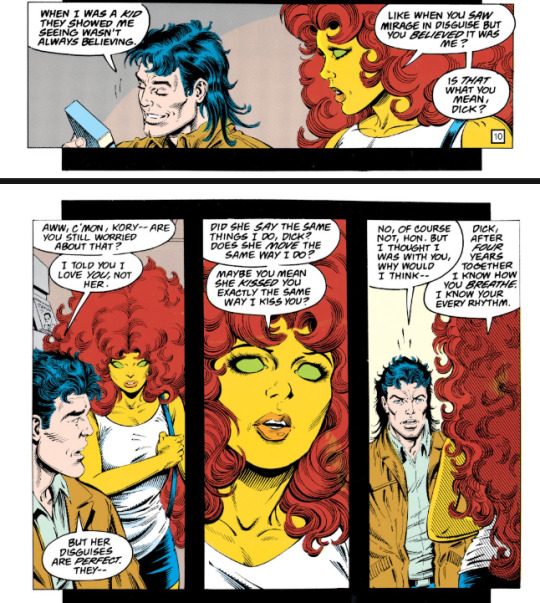
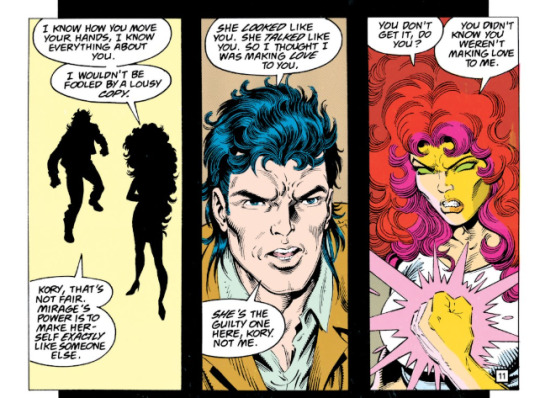
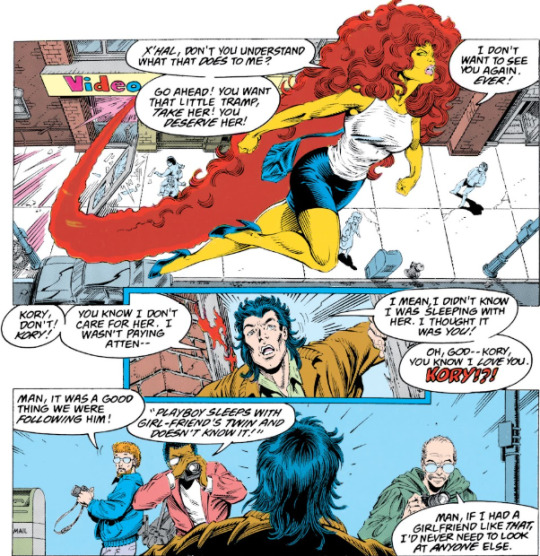
In The New Titans (1984-1996) #99, Nightwing and Starfire argue more about Mirage. Starfire continues to blame Nightwing for being unable to tell that it was Mirage and not Starfire. Nightwing says that "what [Mirage] did repulses me." It ends in Nightwing proposing marriage.
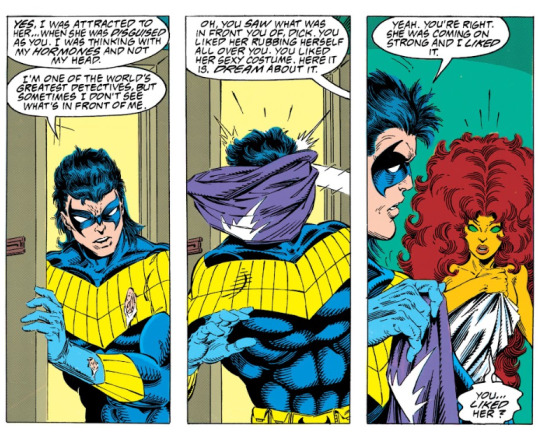
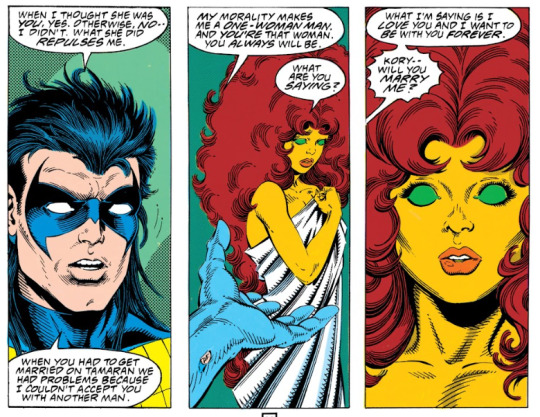
In The New Titans (1984-1996) #100, Nightwing and Starfire prepare to get married. Starfire has doubts, mentioning that Nightwing has "been on edge" lately and complaining that Nightwing was unsympathetic when she got mad that he couldn't tell when he was sleeping with Mirage instead of her. Nightwing and Starfire begin theirvows, and then suddenly several people, including Deathwing (insane Nightwing* from the future) appear to crash the wedding.
Things I found out
Mirage began by stalking Nightwing before he knew who she was.
Mirage first sees present-day Nightwing in The New Titans (1984-1996) #85, but he doesn't see or meet her until Team Titans (1992-1994) #1 (part: Childhood's End). In The New Titans (1984-1996) #86, she is shown spying on Nightwing and Starfire, and it is implied that she continues to do so as some time passes, and she does not appear again until The New Titans (1984-1996) #87. It is clear that Mirage was thinking about raping Nightwing from the first as in The New Titans (1984-1996) #85, she thinks, "he'll be mine."
2. Mirage raped Nightwing multiple times over an extended period.
In The New Titans (1984-1996) #87, Mirage impersonates Dick Grayson to gain entry to Starfire's apartment and then kidnaps and imprisons her. She impersonates Starfire at Starfire's apartment in order to have sex with Nightwing when he visits. On page, they only kiss.
However, the comment Nightwing makes in The New Titans (1984-1996) #88 that Starfire has been "almost ravenous" implies that they have had sex. It also implies a pattern of behaviour--therefore, that some time has passed and that they have had sex multiple times. It is suggested that they have had sex again in Deathstroke, the Terminator (1991-1996) #14.
In The New Titans (1984-1996) #90, Starfire says that she has been imprisoned for "a few days" (let's say 2-6 days). This is the period of time covered in The New Titans (1984-1996) #87-90 and Deathstroke, the Terminator (1991-1996) #14, and it is implied that Mirage repeatedly had sex with Nightwing over the course of this time.
During Team Titans (1992-1994) #2, when Mirage is revealed to be the Starfire imposter, Mirage sexually assaults Nightwing again. She grabs him around the waist and presses up against him whilst talking about how they're fated to be together. Nightwing pushes her off and protests firmly: "Look, I don't know about any future 'us.' Hell, I don't even know you!" At this point, she reveals herself to be his rapist.
3. Even after being discovered, Mirage continued to sexually harass Nightwing.
Mirage spends some time with and even defects to the Titans in Team Titans (1992-1994) #1 (part: Childhood's End), The New Titans (1984-1996) #91, and Team Titans (1992-1994) #2. Although Starfire recognised her as the person who attacked and replaced her in The New Titans (1984-1996) #90, she doesn't tell anyone about this. Mirage introduces herself as Nightwing's lover from the future. She spends a lot of time inflaming Starfire's jealousy. Nightwing is friendly to her. During this time, she does not use her shapeshifting powers, which is how the identity of Nightwing's rapist is not revealed generally until Team Titans (1992-1994) #2.
4. Mirage also sexually assaulted and sexually harassed Starfire.
In The New Titans (1984-1996) #93, Mirage shapeshifts into Starfire and poses for two nude centrefolds in a magazine. This is sexual harassment. The Titans don't react very much to this; it is largely considered an extension of Mirage's needling at Starfire since she joined the Titans. Gar even says: "What's the problem -- you've posed nude before." He then makes a gross comment about having collected and stored the nudes.
In The New Titans (1984-1996) #87, a paparazzi camped out to take photographs outside Starfire's apartment. In The New Titans (1984-1996) #93, they are published, and one photograph is revealed to be of Starfire kissing Dick Grayson (who was actually Mirage). This was how she gained access to Starfire's apartment in The New Titans (1984-1996) #86. It was also sexual assault. As there is also a photograph of Mirage as Starfire kissing Nightwing in his not-Dick-Grayson civilian disguise, this begins a rumour that Starfire is cheating on Nightwing with multiple men.
5. The Titans' unsympathetic reaction to Nightwing's assault was not just that one panel.
Of course, Mirage victim-blames Nightwing, sexually assaulting him in Team Titans (1992-1994) #2 and, when he protests, saying: "If we weren't meant to be, seems you should have sensed the difference." However, she was not the first.
Despite the infamous page that gets bandied about where Pantha calls Nightwing a slut in Team Titans (1992-1994) #2, this was not the first or only reaction to Nightwing's assault. This panel reveals the identity of Nightwing's rapist, who until then was known only as someone who impersonated Starfire. The rape by fraud itself is revealed at the end of Deathstroke, the Terminator (1991-1996) #14.
The time between these two issues is covered in The New Titans (1984-1996) #90-91 and Team Titans (1992-1994) #1 (part: Childhood's End). In these issues, it is clear that Starfire doesn't seem to realise that Nightwing was raped or wronged in any way; she only becomes jealous. In The New Titans (1984-1996) #90, she frames the assault as Mirage having "made Dick love her" and "mak[ing] love with my boyfriend!" She does mention that Mirage "tricked Dick into bed," but she does not seem to consider it an act of violence. In addition, although she recognises Mirage in The New Titans (1984-1996) #90 as the one who attacked her, she doesn't tell anyone about it, including Nightwing. This is why Nightwing is so surprised once Mirage reveals that she was the rapist in Team Titans (1992-1994) #2.
Although all the Titans spent an extended period with Mirage as Starfire over a few days, only Nightwing is blamed for not realising that it was not the real Starfire. The argument seems to be that he should have known because he was sleeping with her.
Pantha is the most and the most continuously gross about Nightwing's assault. Her comments in The New Titans (1984-1996) #90 include:
"Look at 'Wing, there. He should have known. After all, he and the other Star were real kissy while you were, um...out."
"Is Barbie all huffy because Ken-doll made it with Midge?"
"Details! From ten to one--how did she score compared to this one?"
And of course, famously, after the identity reveal in Team Titans (1992-1994) #2, she says, "Dick, you slut! So tell me, who was better? Huh? Huh? Huh?"
After this, Mirage joins the Titans. No one has any serious objection to it, despite Mirage continuing to harass Nightwing and to needle at Starfire. Eventually, Starfire eventually becomes weirdly sympathetic to Mirage, and she begins to victim-blame Nightwing for his assault. In The New Titans (1984-1996) #95, Starfire minimises Mirage's sexual misconduct and rape, calling them "the stunts she pulled," but arguing that "she really seems to care for you, Dick."
Starfire most heavily victim-blames Nightwing during their arguments in The New Titans (1984-1996) #97 and The New Titans (1984-1996) #99. In #97, she makes such arguments as:
"Dick, after four years together I know how you breathe. I know your every rhythm."
"I wouldn't be fooled by a lousy copy."
Nightwing attempts to defend himself with some very good and very firm arguments:
"Her disguises are perfect."
"I thought I was with you, why would I think--"
"Kory, that's not fair. Mirage's power is to make herself exactly like someone else. She looked like you. She talked like you. So I thought I was making love to you. She's the guilty one here, Kory. Not me."
However, Starfire continues to treat the assault as infidelity, responding with: "Go ahead! You want that little tramp, take her! You deserve her!" Then she flies off.
In The New Titans (1984-1996) #99, Nightwing accepts blame for being raped: "I was thinking with my hormones and not my head. I'm one of the world's greatest detectives, but sometimes I don't see what's in front of me." It is implied that this is why Starfire accepts his marriage proposal. However, Nightwing continues to frame Mirage's actions as rape: "She was coming on strong and I liked it. When I thought she was you, yes. Otherwise, no--I didn't. What she did repulses me." It is clear that Nightwing feels violated.
6. The general public also victim-blamed Nightwing.
During this time in The New Titans (1984-1996), the Titans are very concerned about public perception. Paparazzi often follow them around, which is why Nightwing has to wear a disguise when out in public in civvies with Starfire. One paparazzi went so far as to rent out a room for a month across from Starfire's apartment in The New Titans (1984-1996) #87 so that he could camp there to take photographs. When the photographs are published, the Nightwing/Starfire cheating and break-up rumour begins.
This is likely where Nightwing gets the idea to turn Dick Grayson into a playboy. He does this by going on dates with Mirage transformed as different women in The New Titans (1984-1996) #95. Later, Nightwing arranges for Dick Grayson to be photographed kissing Starfire by paparazzi as part of a scheme to have Nightwing/Starfire break up so that Dick Grayson/Starfire can date without compromising his secret identity. It is unclear how Dick Grayson being a playboy is necessary for this plan. I would consider this some type of act of self-harm.
In The New Titans (1984-1996) #97, Dick Grayson and Starfire break up in public as Starfire once again victim-blames him for his rape. When the paparazzi gets a hold of the story, they frame it unsympathetically as "Play-boy sleeps with girl-friend's twin and doesn't know it!" This furthers the image of Dick Grayson as a playboy.
Later, Nightwing becomes homeless. He's not having a good time.
Contemporary Reader Reaction
Team Titans (1992-1994) has a fan letter-and-response column at the end of every couple of issues beginning in #5. They include such sensitive and winning comments as:
"Now, you have to remember how far apart in age the Nightwing of the future was from Mirage, and how much closer in age the present-day Nightwing is. Hence, her more forceful attempts to win him over." - from Jon & co., writers and artists (#5)
"'Dick, you slut! Tell me, who was better? Huh? Huh?' Bwah ha ha ha ha ha ha ha!!!!!" - The Great Buck, fan (#5)
"Pantha's immortal line was praised by all." - Jon & co., writers and artists (#5)
"...and the winner for the favourite one-liner in comics during the year 1992 goes to...Pantha of the New Titans for: 'DICK, YOU SLUT! So, tell me, who was better?' You've definitely got my vote. Pantha's comic relief is very much welcome at a time when despair seems to have grabbed the team by their throats." - Brett A. Tolino, fan (#9)
"the Dick/Kory/Mirage triangle" - from one of Jon & co., writers and artists (#9)
"While I think it's obvious that you're setting up a future romance with Killowat, I can't help but hope you'll be more unpredictable than that, and Miri could actually win Dick away from his longtime girlfriend." - Susan, fan (#11)
"what will the future Grayson do when he learns how Mirage manipulated 'our' Grayson into bed with her?" - Bob Kowalski, fan (#13)
Comics Writers Not Understanding Consent
The writers seemed to consider that Mirage did not rape Nightwing because he should have known that Mirage was not Starfire. Every character who weighs in on the assault expresses that same sentiment. In Team Titans (1992-1994) #2, Mirage says, "If we weren't meant to be, seems you should have sensed the difference."; in The New Titans (1984-1996) #97, Starfire says that "I wouldn't be fooled by a lousy copy." The characters and the writers both link this blame explicitly to Nightwing's detective ability. When Nightwing is talking about one of his inspirations as a detective in The New Titans (1984-1996) #97, he says, "When I was a kid they [episodes of a particular TV show] showed me seeing wasn't always believing." Starfire responds: "Like when you saw Mirage in disguise but you believed it was me?" And when Nightwing apologises for being raped in The New Titans (1984-1996) #99, he says, "I'm one of the world's greatest detectives, but sometimes I don't see what's in front of me." He calls it "thinking with my hormones and not my head." This is made grosser because in retrospect, Nightwing wondering "would Kory even recognise me, if I showed up without a disguise?" in The New Titans (1984-1996) #87 is foreshadowing. Together, this implies that the message from the writers is that Nightwing wondering if Starfire really knows him was hypocritical because he didn't recognise when someone was impersonating Starfire.
In addition, Mirage sexually assaulting and sexually harassing Starfire is entirely glossed over. When Mirage shapeshifts into Starfire and poses for two nude centrefolds in a magazine in The New Titans (1984-1996) #93, no character seems especially concerned except Starfire, who feels violated. Gar comments sarcastically, "Yes. Yes. I agree. Awful. Just awful" after mentioning that he collects Starfire's nude publications. On top of this, the issue itself includes the nude centrefolds as full pages; this seems to be fanservice. It is exploiting something that the writers don't even care to acknowledge is sexual harassment.
Not once do the writers contemporarily acknowledge that any of Mirage's actions are sexual harassment and sexual assault. In the fan letter column in Team Titans (1992-1994) #5, they refer to it as "her [Mirage's] more forceful attempts to win him [Nightwing] over." In the fan letter column in Team Titans (1992-1994) #9, they refer to the situation as "the Dick/Kory/Mirage triangle."
The audience response is not necessarily as positive as is shown in the fan letter quotes above. The culture around male rape victims in the '90s (regarding mostly their apparent lack of existence) needs be acknowledged. However, the tone-deaf comments are as much a fault of the writers and the editors, who obviously chose the fan letters to include and to which to respond. Including them in the letter column without argument in the response indicates a level of approval of their contents. In this way, the writers double-down on Pantha's gross, victim-blaming comments. In the fan letter column in Team Titans (1992-1994) #5, the writers include several letters praising the brilliance of Pantha's comment in Team Titans (1992-1994) #2 where she calls Nightwing a slut, and then they respond, "Pantha's immortal line was praised by all." In the fan letter column in Team Titans (1992-1994) #9, they include a letter that calls the comment "the winner for the favourite one-liner in comics during the year 1992" and "comic relief" that is "very much welcome." In fact, there's some evidence that the audience reacted not well at all. This can be shown by the switching of gears by the writers demonstrated in the next part of the Nightwing/Mirage arc. Somehow, it gets worse.
To Be Continued...
#issue 98 reveals that Starfire has Donald Trump's personal phone number#also I didn't mean to write an essay#i really was just trying to figure out which tpbs to buy#nightwing#mirage#dick grayson#starfire#pantha#the new titans#team titans#cw rape#cw sa
16 notes
·
View notes
Text
The comments have such range. We should shoot them into space so that aliens know not to come here.

Hey guys, my opponent just fused their entire side of the board into a gestalt entity, which is currently dissecting and calcifying my pieces such that they fit into its twisted vision of an eternal, perfect state of the universe. What's the best counter in this situation?
#the genuine chess advice#the off-hand chess advice#the people showing off that they too know chess terms and have seen the queen's gambit#that one comment that managed to mangle two princess bride references at once#the anime references#the anime references from people with clearly very different tastes in anime than the other people#vocaloid fans pulling up to represent#the goths#the gays#the meme openings#i'm pretty sure at least one of them was a dnder#tma (or jon sims?) fans#the hornies#MTG fans I think?#that one reference to an ancient British BBC chess meme#and begrudgingly the destiny fans#tag yourself
37K notes
·
View notes